In the bustling symphony of the culinary world, where flavors dance and aromas intertwine, the saucepan stands as an unsung hero, quietly orchestrating the harmonious blending of ingredients.
It is the quintessential vessel of possibility, where humble beginnings evolve into culinary masterpieces. Much more than a mere kitchen tool, the saucepan embodies versatility, elegance, and above all, the art of culinary finesse.
As steam rises and ingredients meld within its sleek contours, the saucepan transforms the mundane into the extraordinary, inviting both novice cooks and seasoned chefs alike to embark on a journey of culinary exploration and creativity.
So, what exactly is a saucepan? Prepare to delve into the heart of this culinary cornerstone, where simplicity meets sophistication, and every simmering concoction tells a story of flavor and flair.
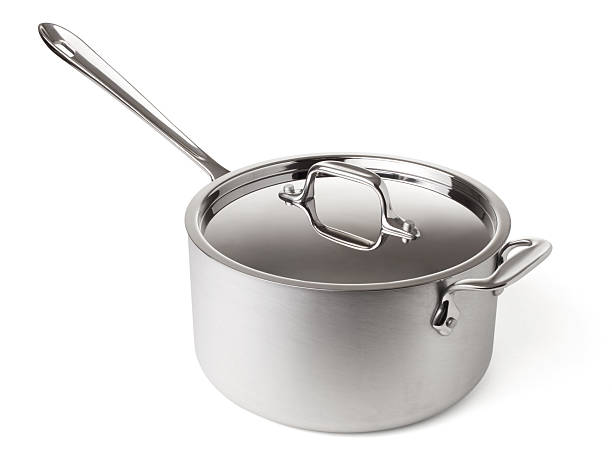
What Is A Saucepan
A saucepan is a fundamental piece of cookware found in almost every kitchen, typically characterized by its deep, straight sides and a long handle.
It is designed for a variety of cooking tasks such as boiling, simmering, and reducing sauces, as well as cooking grains, vegetables, and small portions of food. Saucepans come in various sizes, materials, and designs, ranging from small one-quart pans to larger capacities.
They are usually made from stainless steel, aluminum, copper, or enamel-coated cast iron, each offering different heat conductivity and durability properties.
The versatility of saucepans makes them indispensable for everyday cooking, enabling precise control over temperature and facilitating the creation of flavorful sauces and dishes.
What is it used for?
A saucepan is primarily used for a variety of cooking tasks such as:
- Boiling: Saucepans are ideal for boiling water for cooking pasta, rice, vegetables, or making soups and stocks.
- Simmering: They are used for gently simmering sauces, gravies, and liquids to develop flavors without rapid boiling.
- Reheating: Saucepans are handy for reheating leftovers or pre-cooked foods.
- Making sauces: Their deep, straight sides are perfect for whisking and reducing sauces like béchamel, hollandaise, or tomato sauce.
- Cooking grains: Saucepans are commonly used for cooking grains such as rice, quinoa, or oatmeal.
- Steaming: With the addition of a steamer insert, saucepans can be used for steaming vegetables, fish, or dumplings.
Overall, the versatility of saucepans makes them indispensable for various cooking tasks, from simple boiling to intricate sauce-making, making them a staple in any kitchen.
What does a saucepan look like?
A saucepan typically has a cylindrical shape with relatively high, straight sides and a flat bottom. The sides are usually taller than those of a frying pan or skillet, allowing for the containment of liquids and sauces.
The handle of a saucepan is long and typically made of the same material as the pan itself, such as stainless steel or heat-resistant plastic. This handle facilitates easy lifting and maneuvering of the saucepan on the stovetop.
The size of a saucepan can vary, ranging from small one-quart pans to larger capacities depending on the intended use. They are commonly made from materials like stainless steel, aluminum, copper, or enamel-coated cast iron, each offering different heat conductivity and durability properties.
Overall, the appearance of a saucepan is characterized by its practical design, suitable for a wide range of cooking tasks in the kitchen.
What are saucepans made of?
Saucepans can be made of various materials, each offering different properties and benefits:
Stainless Steel
Stainless steel saucepans are popular due to their durability, resistance to rust and corrosion, and ease of maintenance. They are also non-reactive, meaning they won’t interact with acidic or alkaline ingredients, making them suitable for cooking a wide range of dishes.
Aluminum
Aluminum saucepans are lightweight and excellent conductors of heat, allowing for quick and even heating. However, pure aluminum can react with acidic foods, so most aluminum saucepans are coated with a non-stick or anodized layer to prevent this.
Copper
Copper saucepans are prized for their superior heat conductivity, which allows for precise temperature control. They heat up and cool down quickly, making them ideal for delicate sauces and tasks that require rapid adjustments in temperature. However, copper can react with certain foods, so copper saucepans are often lined with stainless steel or tin.
Enamel-coated Cast Iron
Cast iron saucepans coated with enamel offer the benefits of cast iron’s excellent heat retention and distribution, along with the non-reactivity and easy maintenance of enamel. They are suitable for long, slow cooking and can also be used for acidic foods without worry of reaction.
Non-stick
Some saucepans are coated with a non-stick surface, typically made from materials like PTFE (Teflon) or ceramic. These saucepans are convenient for cooking delicate foods that might otherwise stick to the pan, but they require gentle care to maintain the integrity of the non-stick coating.
What sizes do saucepans come in?
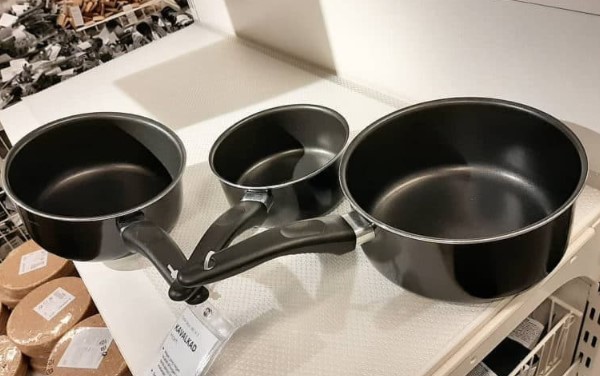
Saucepans come in a range of sizes to accommodate various cooking needs. Common sizes for saucepans include:
Small saucepans
Small saucepans typically have a capacity of around 1 to 2 quarts (0.9 to 1.8 liters). They are perfect for tasks that require heating or cooking small amounts of food or liquids.
These saucepans are commonly used for tasks such as melting butter, heating milk, boiling eggs, or making small portions of sauces, gravies, or custards. Their compact size makes them ideal for single servings or cooking for one or two people.
Small saucepans are convenient for tasks that require precise temperature control, such as melting chocolate or making delicate sauces that could easily scorch in larger pans.
They are a versatile addition to any kitchen, suitable for both everyday cooking and specialized culinary endeavors.
Medium saucepans
Medium saucepans typically range in capacity from 2 to 4 quarts (1.8 to 3.8 liters), providing versatility for a variety of cooking tasks. These saucepans are well-suited for everyday cooking needs in households of varying sizes.
With their moderate size, they are ideal for tasks such as boiling vegetables, cooking grains like rice or quinoa, simmering sauces or soups, and reheating leftovers.
Medium saucepans strike a balance between accommodating larger portions of food while still being manageable and easy to handle on the stovetop. Their size makes them suitable for cooking for small to medium-sized families or for preparing meals with multiple components.
Medium saucepans often come with lids, allowing for better heat retention and the option to cover dishes while simmering or steaming. Overall, medium saucepans are essential kitchen staples, offering versatility and convenience for a wide range of cooking needs.
Large saucepans
Large saucepans typically have a capacity ranging from 4 to 6 quarts (3.8 to 5.7 liters), making them indispensable for cooking larger quantities of food. These saucepans are ideal for preparing family meals, batch cooking, or entertaining guests.
With their generous size, large saucepans can accommodate tasks such as making large batches of soups, stews, or sauces, boiling pasta, and blanching vegetables. They are also suitable for tasks that require ample space, such as cooking whole grains, braising meats, or deep-frying.
The depth and volume of large saucepans allow for efficient heat distribution and even cooking, making them versatile tools for a wide range of culinary endeavors. Many large saucepans come with sturdy handles and lids, providing ease of handling and heat retention during cooking.
Whether for everyday cooking or special occasions, large saucepans are essential for efficiently preparing hearty and satisfying meals for family and friends.
Extra-large saucepans
Extra-large saucepans are designed for cooking substantial quantities of food, typically exceeding 6 quarts (5.7 liters) in capacity. These saucepans are often used in professional kitchens, catering services, or for cooking large meals for events and gatherings.
With their expansive size, extra-large saucepans are capable of handling bulk cooking tasks with ease. They can accommodate cooking tasks such as preparing large batches of stocks, soups, or sauces, boiling considerable amounts of pasta or grains, and simmering stews or chili for a crowd.
The depth and width of extra-large saucepans provide ample space for stirring and maneuvering ingredients, ensuring even cooking and flavor distribution. Many extra-large saucepans are constructed with durable materials and reinforced handles to support the weight of large quantities of food.
Despite their substantial size, these saucepans are designed to deliver efficient heat distribution and precise temperature control, making them indispensable tools for cooking on a large scale.
Why is it called a saucepan?
The term “saucepan” likely originates from the purpose for which it was originally designed: to make sauces. The word “pan” traditionally refers to a shallow, flat-bottomed cooking vessel, while “sauce” indicates its intended use for cooking sauces.
Therefore, the combination “saucepan” denotes a pan specifically designed for preparing sauces. Over time, the functionality of saucepans has expanded to include a wide range of cooking tasks beyond just making sauces, but the name has persisted due to its historical association with this particular culinary use.
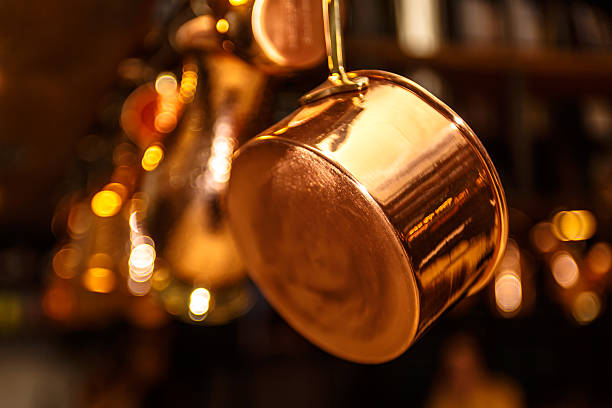
What is the difference between a saucepan and a pot?
The main difference between a saucepan and a pot lies in their design, size, and typical uses:
Design and Size
- Saucepan: A saucepan typically has taller, straight sides and a smaller capacity compared to a pot. It often has a long handle on one side for easy maneuvering on the stovetop.
- Pot: A pot generally has shorter, more sloped sides and a larger capacity than a saucepan. It may have two handles on opposite sides for lifting and pouring.
Typical Uses
- Saucepan: Saucepans are primarily used for cooking tasks that involve liquids, sauces, and smaller portions of food. They are well-suited for boiling, simmering, reheating, and making sauces, as well as cooking grains, vegetables, and small cuts of meat.
- Pot: Pots are versatile vessels used for cooking larger quantities of food. They are commonly employed for boiling pasta, preparing soups, stews, stocks, and chili, as well as braising meats and blanching vegetables.
Versatility
- Saucepan: While saucepans are versatile in their own right, they are generally better suited for tasks requiring precise temperature control and handling smaller volumes of food.
- Pot: Pots are more versatile for cooking larger batches of food and can accommodate a wider range of cooking techniques due to their larger size and capacity.
What is the difference between a saucepan and a skillet?
The difference between a saucepan and a skillet lies primarily in their design, shape, and typical uses:
Design and Shape
- Saucepan: A saucepan typically features taller, straight sides and a flat bottom. It is designed for tasks involving liquids, such as boiling, simmering, and making sauces. Saucepans often come with a long handle on one side for easy maneuvering on the stovetop.
- Skillet: A skillet, also known as a frying pan, has low, sloped sides that gradually flare outwards. It usually features a wide cooking surface and may have a long handle and a smaller helper handle on the opposite side for lifting. Skillets are designed for tasks such as frying, sautéing, searing, and browning food.
Typical Uses
- Saucepan: Saucepans are primarily used for cooking tasks involving liquids and small portions of food. They are ideal for boiling water, simmering sauces, reheating leftovers, and cooking grains, vegetables, and sauces.
- Skillet: Skillets are versatile pans used for cooking a wide range of foods over high heat. They are commonly employed for frying eggs, searing meats, sautéing vegetables, making stir-fries, and preparing dishes that require browning or caramelization.
Versatility
- Saucepan: While saucepans are versatile for cooking tasks involving liquids and smaller portions of food, they are not as well-suited for high-heat cooking techniques like frying or searing.
- Skillet: Skillets are highly versatile and can handle a variety of cooking techniques due to their wide cooking surface and low, sloped sides. They excel at cooking food quickly and evenly over high heat.
What do you cook in a saucepan?
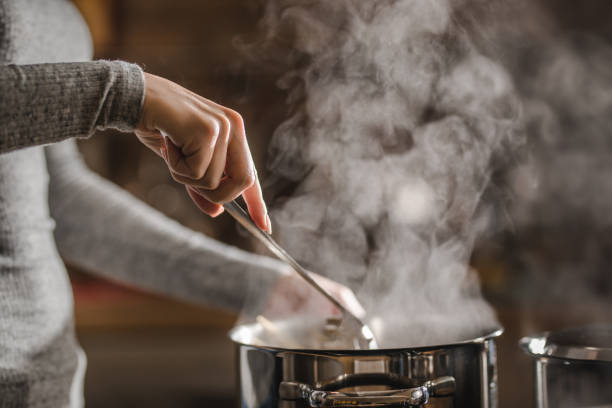
A saucepan is a versatile piece of cookware that can be used to prepare a wide variety of dishes. Its design, featuring tall, straight sides and a flat bottom, makes it ideal for tasks such as boiling, simmering, and reducing liquids.
Commonly cooked foods in a saucepan include sauces, gravies, and soups, where the even heat distribution facilitates thorough cooking and flavor development. Saucepans are perfect for cooking grains like rice, quinoa, or oats, ensuring they are cooked to perfection without sticking or burning.
Vegetables can also be steamed or blanched in a saucepan, preserving their nutrients and vibrant colors. Furthermore, saucepans are ideal for tasks requiring precise temperature control, such as melting chocolate or butter for baking.
From simple everyday meals to elaborate culinary creations, the saucepan’s versatility makes it an indispensable tool in any kitchen.
The Advantages of the Saucepan
The saucepan offers several advantages in the kitchen:
- Versatility: Saucepans are incredibly versatile cookware pieces suitable for a wide range of cooking tasks. From boiling water to simmering sauces, cooking grains, vegetables, and small portions of food, saucepans can handle various culinary needs.
- Precise Temperature Control: The tall, straight sides of saucepans facilitate precise temperature control, making them ideal for tasks that require gentle cooking, such as simmering sauces or melting chocolate. Their design allows for even heat distribution, preventing hot spots and promoting uniform cooking.
- Efficient Sauce Making: As the name suggests, saucepans are particularly well-suited for making sauces. Their design promotes reduction and evaporation, helping sauces thicken and develop flavor. The small size of saucepans also allows for efficient stirring and whisking, essential for achieving smooth and well-emulsified sauces.
- Convenience: Saucepans are typically equipped with long handles, making them easy to lift, maneuver, and pour. Additionally, many saucepans come with lids, which are useful for trapping heat and steam, reducing cooking time, and preventing splatters.
- Space-Saving: Saucepans come in various sizes, including small and medium options, making them suitable for kitchens with limited storage space. Their compact design allows them to be stacked or nested together, minimizing clutter in the kitchen.
- Easy Maintenance: Saucepans are usually made from durable materials such as stainless steel or non-stick coatings, which are easy to clean and maintain. Many saucepans are dishwasher safe, saving time and effort on cleanup.
The Disadvantages of the Saucepan
While saucepans are incredibly versatile and useful in the kitchen, they also have some limitations and disadvantages:
- Limited Cooking Capacity: Saucepans are generally smaller in size compared to pots or Dutch ovens, which limits the quantity of food that can be cooked in them. This can be a disadvantage when cooking for larger families or preparing meals in bulk.
- Not Suitable for High-Heat Cooking: Due to their tall, straight sides and smaller surface area, saucepans are not ideal for high-heat cooking methods such as searing or frying. They may not provide enough space for ingredients to brown evenly or develop a crispy exterior.
- Uneven Heat Distribution: Some saucepans may have issues with uneven heat distribution, particularly if they are made from thinner materials. This can result in hot spots and uneven cooking, affecting the quality of the food being prepared.
- Limited Versatility for Certain Cooking Tasks: While saucepans are versatile, they may not be the best choice for certain cooking tasks that require specialized cookware. For example, they may not be suitable for baking or roasting, which require the use of an oven.
- Difficulty with Cleaning Certain Designs: Saucepans with intricate designs or hard-to-reach crevices may be more challenging to clean effectively. Food particles and residue can get trapped in these areas, requiring extra effort to ensure thorough cleaning.
- Potential for Boil-Overs: Because saucepans have tall sides and narrow openings, they are more prone to boil-overs when cooking liquids at high temperatures. This can create a mess on the stovetop and require extra cleanup.
Best Saucepans To Buy
The saucepans you mentioned offer various features and benefits, each suitable for different preferences and cooking needs:
Michelangelo Stainless Steel 3 Saucepan Set
This set is likely a reliable option for those who prefer stainless steel cookware. Stainless steel saucepans are durable, resistant to corrosion, and do not react with acidic foods.
They typically offer even heat distribution, making them suitable for a wide range of cooking techniques. A set containing multiple sizes provides versatility for cooking different quantities of food.
Zunmial Copper Colored Saucepans with Lids
Copper-colored saucepans often feature a non-stick interior coating, providing easy food release and cleanup. While they may not have the heat conductivity of pure copper, they still offer efficient heat distribution and are lightweight.
The addition of lids helps retain moisture and heat during cooking, enhancing the versatility of the saucepans.
Carote Nonstick Granite Cookware Set
Non-stick granite cookware sets, like the one mentioned, are popular for their durability and ease of use. They are typically scratch-resistant, dishwasher-safe, and require minimal oil for cooking, making them a healthier option.
Non-stick coatings also facilitate easy cleaning. This set likely includes saucepans with lids, providing convenience and versatility for various cooking tasks.
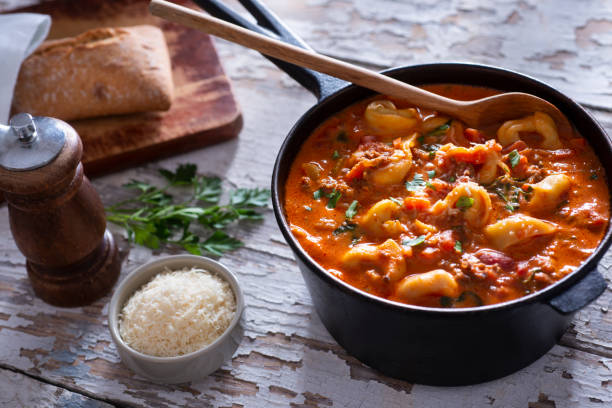
Frequently Asked Questions (FAQs) – What Is A Saucepan
What exactly is a saucepan?
A saucepan is a versatile kitchen essential designed for cooking liquids, sauces, and small quantities of food. Its compact size and sturdy construction make it ideal for a variety of culinary tasks.
Why should I invest in a quality saucepan?
Investing in a quality saucepan ensures even heat distribution, durability, and efficient cooking. Whether you’re simmering soups, boiling pasta, or making delicate sauces, a good saucepan can elevate your culinary creations.
How do I choose the right saucepan for my needs?
Consider factors such as material (stainless steel, copper, non-stick), size, and handle design when selecting a saucepan. Think about your cooking preferences and the types of dishes you frequently prepare to guide your decision.
What are the advantages of using a saucepan?
Saucepans offer precise temperature control, making them perfect for tasks that require gentle heating or simmering. Additionally, their compact size and pour spouts make them convenient for pouring liquids without spills.
Can I use a saucepan for more than just making sauces?
Absolutely! Saucepans are incredibly versatile and can be used for a wide range of cooking tasks, including boiling eggs, reheating leftovers, melting butter, and cooking grains such as rice or quinoa.
How do I properly care for my saucepan to ensure longevity?
To prolong the life of your saucepan, hand wash it with mild detergent and avoid using abrasive cleaners or utensils that could scratch the surface. Avoid extreme temperature changes and always dry your saucepan thoroughly after washing.
Are saucepans suitable for all types of stovetops?
Most saucepans are compatible with gas, electric, and induction stovetops, but it’s essential to check the manufacturer’s specifications to ensure compatibility. Some materials, such as copper, may require specific care on certain stovetop surfaces.
How can I make the most of my saucepan in the kitchen?
Experiment with different recipes and cooking techniques to fully explore the versatility of your saucepan. From simple sauces to one-pot meals, there’s no limit to what you can create with this essential kitchen tool.
Are saucepans suitable for beginners in the kitchen?
Absolutely! Saucepans are user-friendly and perfect for beginners learning their way around the kitchen. Start with basic recipes and gradually expand your culinary skills as you become more comfortable using your saucepan.
Where can I find quality saucepans to purchase?
Quality saucepans are available at kitchen supply stores, department stores, and online retailers. Look for reputable brands known for their durable construction and reliable performance to ensure you’re getting a saucepan that will last for years to come.
Conclusion
In conclusion, the saucepan stands as a quintessential tool in the culinary world, serving as a versatile vessel for countless cooking tasks. Its design, characterized by a sturdy handle, a rounded bottom, and tall, straight sides, embodies functionality and efficiency.
From simmering sauces to boiling water, the saucepan’s adaptability makes it an indispensable asset in kitchens worldwide. Whether in the hands of a professional chef or a home cook, its simplicity belies its significance in achieving culinary excellence.
As we embrace the art and science of cooking, the humble saucepan remains an enduring symbol of culinary craftsmanship and innovation.